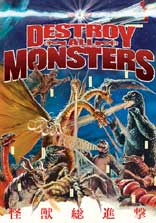 DESTROY
ALL MONSTERS (1968)
DESTROY
ALL MONSTERS (1968)Tokyo Shock/Media Blasters
Directed by Ishiro Honda
 DESTROY
ALL MONSTERS (1968)
DESTROY
ALL MONSTERS (1968)By 1968, Toho Company Ltd. was the reigning factory for giant monsters-on-the-loose films. Having created such cinematic pop icons as Godzilla, Rodan, Mothra, King Ghidorah, and Minira (Godzilla’s son) plus many more, producer Tomoyuki Tanaka originally decided to end the kaiju eiga (monster film) series on a high note with this historic collection of eleven giant monsters in one epic film. Finally, after a series of delays and rumors as well as a decidedly sub-standard American DVD release from another company in 2000 and 2004 respectively, DESTROY ALL MONSTERS (KAIJU SHOSHENGEKI) gets its well-deserved definitive DVD/Blu-ray release from Media Blasters who already have an excellent track record of releasing Toho science fiction films to North American DVD since 2005.
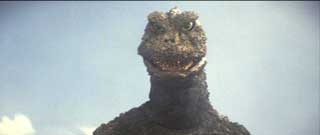
The year is 1999. All of Earth’s giant monsters (Godzilla, Rodan,
Mothra, Anguilas, Gorosaurus, Spiega, Minira, Varan, Manda, and Baragon) have
been collected and confined to Ogasawara Island by the United Nations Scientific
Committee in an effort to study the creatures as well as keep them out of mischief.
The island (christened “Monsterland” by the committee) is a peaceful
zoo-like animal preserve until nefarious aliens (the Kilaaks) invade Earth and
take control of the monsters’ minds. The evil invaders then send the monsters
to trash the world (Godzilla in New York, Rodan in Moscow, Mothra in Peking,
Manda in London, Gorosaurus in Paris). Eventually, four of the giant brutes
(Godzilla, Rodan, Mothra, and Manda) gang up on Tokyo in a spectacular special
effects extravaganza. It then falls upon the brave astronauts from spaceship
Moonlight SY-3 to seek out the aliens’ hideout (both on the moon and on
Earth) and break their control over the marauding monsters. The result is a
frenzied, thrilling, and noisy climax in which all the good monsters take on
the Kilaaks’ protector, King Ghidorah, at the base of Mt. Fuji.
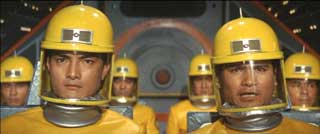 DESTROY
ALL MONSTERS is arguably one of Toho’s finest kaiju eiga hours. It is
a fast-paced 89 minutes with enough special effects pyrotechnics to satisfy
even the most discriminating and hardcore monster movie fan. In addition to
the comic book-like style of the script with earnest good guys and slimy space
villains, it features all of music maestro Akira Ifukubie’s great and
familiar monster themes which sound particularly epic and rousing in this film.
DESTROY
ALL MONSTERS is arguably one of Toho’s finest kaiju eiga hours. It is
a fast-paced 89 minutes with enough special effects pyrotechnics to satisfy
even the most discriminating and hardcore monster movie fan. In addition to
the comic book-like style of the script with earnest good guys and slimy space
villains, it features all of music maestro Akira Ifukubie’s great and
familiar monster themes which sound particularly epic and rousing in this film.
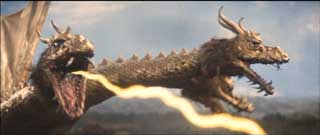
The cast of DESTROY ALL MONSTERS is made up of Toho’s A-list talent genre fans have come to know and love. Akira Kubo headlines as the brave astronaut Kazuo Isai with the lovely Yuriko Kobayashi as his pretty girlfriend Kyoko who becomes possessed by the aliens’ mind control device. Jun Tazaki plays his usual brilliant scientist role of Dr. Yoshida with an authoritative demeanor. Yoshio Tsuchiya has a smaller role as alien possessed Dr. Otami, but manages to steal the show for the time he is on screen. Mr. Tsuchiya was known for these offbeat roles as he played the leader of THE MYSTERIANS in 1957 and “the Controller of Planet X” in MONSTER ZERO (1965) as well as his very memorable turn as the tragic and lovesick “Mizuno” in THE HUMAN VAPOR (1960). Familiar Toho faces like Kenji Sahara, Nadao Kirino, Yutaka Sada, and Yoshifumi Tajima also appear in the supporting cast. Kyoko Ai also has a memorable role as the evil alien queen flashing her demonic smile as she sets about conquering everything in sight.
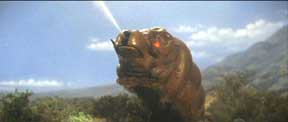 The
previous two films in the Godzilla series, 1966’s GODZILLA VS. THE SEA
MONSTER and 1967’s SON OF GODZILLA, featured Jun Fukada as director with
musical scores for both by Masaru Sato. Since producer Tomoyuki Tanaka originally
envisioned DESTROY ALL MONSTERS as the end of the Godzilla saga, he staffed
the film with all of Godzilla’s original creators (Ishiro Honda (director),
Eiji Tsuburaya (special effects), and Akira Ifukubie (music) in an effort to
let the series end on as high as an artistic note as possible. However, the
film did excellent box-office business in Japan and even greater business in
the United States where American International Pictures heavily promoted the
film in 1969. It was a veritable staple on the drive-in circuit for several
years where it was double, triple, and quadruple billed with a variety of AIP
cult films like BARON BLOOD (1972), THE INCREDIBLE TWO HEADED TRANSPLANT (1971),
THE THING WITH TWO HEADS (1972), KONGA (1961), REPTILICUS (1962), and AIP releases
of Toho’s GODZILLA VS. THE THING (1964), FRANKENSTEIN CONQUERS THE WORLD
(1966), YOG—MONSTER FROM SPACE (1971) and GODZILLA VS. THE SMOG MONSTER
(1972). This worldwide box office success as well as the film’s cult classic
reputation convinced Mr. Tanaka to continue the Godzilla franchise for all it
was worth even though there was a significant reduction of quality in the Godzilla
films of the 1970s. The initial series of films finally came to an end in 1975
with THE TERROR OF MECHAGODZILLA.
The
previous two films in the Godzilla series, 1966’s GODZILLA VS. THE SEA
MONSTER and 1967’s SON OF GODZILLA, featured Jun Fukada as director with
musical scores for both by Masaru Sato. Since producer Tomoyuki Tanaka originally
envisioned DESTROY ALL MONSTERS as the end of the Godzilla saga, he staffed
the film with all of Godzilla’s original creators (Ishiro Honda (director),
Eiji Tsuburaya (special effects), and Akira Ifukubie (music) in an effort to
let the series end on as high as an artistic note as possible. However, the
film did excellent box-office business in Japan and even greater business in
the United States where American International Pictures heavily promoted the
film in 1969. It was a veritable staple on the drive-in circuit for several
years where it was double, triple, and quadruple billed with a variety of AIP
cult films like BARON BLOOD (1972), THE INCREDIBLE TWO HEADED TRANSPLANT (1971),
THE THING WITH TWO HEADS (1972), KONGA (1961), REPTILICUS (1962), and AIP releases
of Toho’s GODZILLA VS. THE THING (1964), FRANKENSTEIN CONQUERS THE WORLD
(1966), YOG—MONSTER FROM SPACE (1971) and GODZILLA VS. THE SMOG MONSTER
(1972). This worldwide box office success as well as the film’s cult classic
reputation convinced Mr. Tanaka to continue the Godzilla franchise for all it
was worth even though there was a significant reduction of quality in the Godzilla
films of the 1970s. The initial series of films finally came to an end in 1975
with THE TERROR OF MECHAGODZILLA.
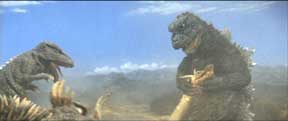
After playing the drive-in circuit throughout the early 1970s, DESTROY ALL MONSTERS also had its life extended through countless showings on Saturday afternoon and late-night independent American television stations throughout the late 1970s into the early 1980s. In the New York City/Long Island area, the movie was a fixture on WPIX’s CHILLER THEATER, SCIENCE FICTION THEATER, as well as THE CHANNEL 11 FILM FESTIVAL for many years.
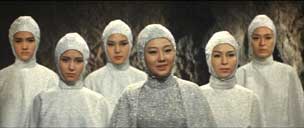 Media
Blasters’ DVD presentation is on par with their other excellent DVD releases
of Toho product. The video presentation is a gorgeous anamorphic 2.35:1 High
Definition transfer showing sharpness, clarity, and detail illustrating deep
and rich colors. This is truly the best this reviewer has ever seen this film
and it was like watching the movie for the very first time. There is plethora
of audio tracks including…yes, the rumors were in fact true…the
nostalgic AIP/Titan dub with which people of this reviewer’s age group
(42 years-old) are most familiar. The other audio choices include Toho’s
inferior and horrible acted “international” English dub done in
1968 by William Ross’ Frontier Enterprises; a Japanese language track
in 2.0; a Japanese language track in 3.2/1 surround sound; and an audio commentary
track by Godzilla film experts Ed Godziszewski and Steve Ryfle. Of course, the
best sounding tracks are the Japanese language versions followed by the “international”
version as they are all provided by Toho. The AIP/Titan audio track is good
and it is great to have it included unfortunately, the only available source
was reportedly a VHS copy of a 16mm print and the audio was culled from that.
As a result there is somewhat of a tinny sound and the audio is somewhat choppy
(as if the film was skipping) at the very beginning of the film. However, genre
fans should by grateful that Media Blasters added this track at all and fans
will never again see the AIP dub synchronized to such a gorgeous video.
Media
Blasters’ DVD presentation is on par with their other excellent DVD releases
of Toho product. The video presentation is a gorgeous anamorphic 2.35:1 High
Definition transfer showing sharpness, clarity, and detail illustrating deep
and rich colors. This is truly the best this reviewer has ever seen this film
and it was like watching the movie for the very first time. There is plethora
of audio tracks including…yes, the rumors were in fact true…the
nostalgic AIP/Titan dub with which people of this reviewer’s age group
(42 years-old) are most familiar. The other audio choices include Toho’s
inferior and horrible acted “international” English dub done in
1968 by William Ross’ Frontier Enterprises; a Japanese language track
in 2.0; a Japanese language track in 3.2/1 surround sound; and an audio commentary
track by Godzilla film experts Ed Godziszewski and Steve Ryfle. Of course, the
best sounding tracks are the Japanese language versions followed by the “international”
version as they are all provided by Toho. The AIP/Titan audio track is good
and it is great to have it included unfortunately, the only available source
was reportedly a VHS copy of a 16mm print and the audio was culled from that.
As a result there is somewhat of a tinny sound and the audio is somewhat choppy
(as if the film was skipping) at the very beginning of the film. However, genre
fans should by grateful that Media Blasters added this track at all and fans
will never again see the AIP dub synchronized to such a gorgeous video.
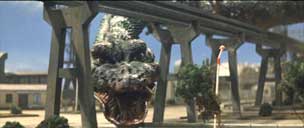
Additional extras include a gallery of posters (U.S., Japanese, Italian, French, etc.) as well as the U.S., Japanese, and French trailers. Also there is an image gallery of production stills and behind-the-scenes photos. However the best extra of them all is an Easter Egg when one clicks on the title of the Japanese poster in the special features section…it is (and this is NO joke) the Ken Films super 8 color and sound eight minute digest of DESTROY ALL MONSTERS. Genre fans will absolutely have a ball with this blast from the past of watching 8mm digests on the old movie screens (or on living room walls) in the long ago days before the advent of VHS/DVD/Blu-Ray.
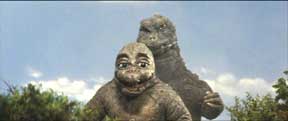 Media
Blasters has once again come through and treated this oft-requested Toho classic
with the dignity and respect it richly deserves. The company’s next Godzilla
excursion will be a November DVD/Blu-Ray release of GODZILLA VS. MEGALON (which
will be reviewed here at DVD Drive-In). After years of horrible pan and scan
releases on VHS/DVD of this formerly public domain title, it will be nice to
see this film in the hands of such capable people as the good folks at Media
Blasters. (Joe
Cascio)
Media
Blasters has once again come through and treated this oft-requested Toho classic
with the dignity and respect it richly deserves. The company’s next Godzilla
excursion will be a November DVD/Blu-Ray release of GODZILLA VS. MEGALON (which
will be reviewed here at DVD Drive-In). After years of horrible pan and scan
releases on VHS/DVD of this formerly public domain title, it will be nice to
see this film in the hands of such capable people as the good folks at Media
Blasters. (Joe
Cascio)